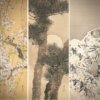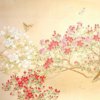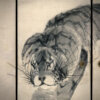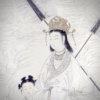Nagasaki School: Born with Great Influence from Foreign Countries.
The Nagasaki School was a collective term for the various schools of painting that emerged in Nagasaki during the closed system of the Edo period, when there were negotiations only with the Dutch and Qing dynasties.
Overview
These schools are divided into six groups: the Hokushū school (a northern school of Chinese painting), the Ōbaku school (a school of painting introduced by monks from the Ming Dynasty), the Nanpin school (a school of painting introduced by Shen Nanpin), the Nanshū school (a southern school of Chinese painting, literati school), the Western-style school, and Nagasaki prints.
New styles introduced through Nagasaki spread to the art world in Kamigata (Kyōto and Ōsaka) and Edo, giving rise to a new style of painting. The influence of the Nanpin school was particularly significant, and the pursuit of realism was born.
History
Nagasaki was frequently visited by painting priests and painters from the Qing dynasty.
The first visit to Japan was made by the Ōbaku monk Itsunen Shōyū (Chinese: 逸然性融, 1601 in Hangzhou, Zhejiang, China – 1668 in Nagasaki, Japan) in the 1644-48 Shōhō period (1644-48), and since then Shen Nanpin, Yi Hai (Chinese: 伊海, or Yi Fujiu (伊桴鳩), I Fukyū in Japanese), and Hi Kangen have all visited Japan.
The history of the Nagasaki School of painting after the isolation of Japan can be divided into two periods.
- The first period: The period after the departure of the Portuguese, when Chinese culture, especially the Ōbaku culture, was introduced by exiled Chinese who had fled the warfare of the late Ming and early Qing dynasties (mid to late 17th century).
- The second period: the beginning of the 19th century, when Karaemekiki job painters and town painters mixed and interacted with the Qing dynasty painting style.
For more than 200 years, the unique situation of Nagasaki, which was the first to receive foreign culture, shaped the Nagasaki School. After the opening of Japan to the outside world, however, the Nagasaki School gradually declined, despite the popularity of the artists of the Nanshū school (literati painting), such as Tetsuō Somon and Kinoshita Itsuun, and its role came to an end in the Meiji period (1868-1912).
Various Schools
Hokushū School (a Northern School of Chinese Painting)
This painting school is known as “Nagasaki Kanga” or “Karae” and is mainly influenced by Ming and Qing paintings. This is a different style of Chinese painting from the ink painting of the Muromachi period, which imitated the painting style of the Song and Yuan dynasties. The Ōbaku monk Itsunen Shōyū, who came to Japan in 1642, is known as the founder of Nagasaki Kanga and painted many Dōshaku portraits (paintings depicting Taoist and Buddhist figures), including those of Arhats, Bodhidharma (Daruma), and Budai (Chinese: 布袋; pinyin: Bùdài; Korean: 포대, romanized: Podae; Japanese: 布袋, romanized: Hotei). Before Itsunen Shōyū, other visiting painters such as Fan Dao-sheng, Chen Huang, and Chen Xuanxing also produced works. The Dōshaku portraits by Chen Yin were also brought to Japan several times by visiting monks. Among Itsunen Shōyū’s pupils were Kawamura Jakushi and Watanabe Shūseki, who worked in the Hokusō style of Chinese painting. In addition to Itsunen Shōyū, there were many other Ōbaku monks who enjoyed painting, and this school is considered the mainstream of the Nagasaki School.
Kawamura Jakushi formed a family and was followed by Ueno Jakugen, Yamamoto Jakurin, Ushijima Jakuyū, and others until the end of the Edo period.
Ōbaku School (a School of Painting Introduced by Monks from the Ming Dynasty)
Among the artworks of the Ōbaku school, which was brought to Japan by the monks of the Ōbaku school, *chinsō is characterized by the richness of its colours, the frontality of its face, and its shading. It is in the style of Zheng Jing, a portrait painter active in the Jiangnan region during the Ming dynasty. Ingen Ryūki (traditional Chinese: 隱元隆琦; pinyin: Yǐnyuán Lóngqí; Japanese: 隠元隆琦) brought to Japan the “Portrait of Feiyin Tungrong” was created by Zhanggi, a student of Zheng Jing, and was received with great excitement by the artists of the time. Yang Daozhen, also from Zheng Jing’s family, was a painter who accompanied Ingen and worked mainly on Ingen’s portraits. His pupil Kita Dōku worked mainly on the chinsō of Ingen, Mu’an (Chinese: Mù’ān Xìngtāo; Japanese: Mokuan Shōtō) and Sokuhi Nyoitsu (pinyin Jifei Ruyi, ( (1616-1671)). Kita Genki, the son of Kita Dōku, is one of the most famous representatives of the Ōbaku school, having painted over 200 portraits of not only Ōbaku monks, but also resident Chinese and feudal lords. The expressive style of the Ōbaku school was later inherited by Kakutei and Katayama Yōkoku, and mixed with the Nanpin school to create a unique style of painting. Its realistic expression also influenced Nagasaki prints (Nagasaki-e).
- *Chinsō (Japanese: 頂相 [tɕiɰ̃soː]; alternatively pronounced Chinzō [tɕindzoː]) are commemorative portraits of Zen masters, a traditional form of East Asian art, specifically Zen art.
Nanpin School
A school of painting formed by the Qing dynasty painter Shen Nanpin and his followers, who arrived in Japan in 1731. Their work was characterized by detailed, colourful paintings of flowers and birds. This style triggered the rise of emerging artists such as Maruyama Ōkyo and Itō Jakuchū.
Nanshū School (a Southern School of Chinese Painting, Literati School)
In 1720, Yi Hai (Chinese: 伊海, or Yi Fujiu (伊桴鳩), I Fukyū in Japanese) arrived in Nagasaki and introduced the nanshū painting to the region. Many painters, including Ikeno Taiga and Kuwayama Gyokushū, admired him personally. Following him came Hi Kangen (1734), Chō Shūkoku (1786) and Jiang Jiapu (1804). Together they are known as the “Big 4 of Visiting Chinese Painters”. Many other Qing artists, such as Sō Shigan, Jo Utei, and Chen Yizhou, also introduced the nanshū painting to Nagasaki. It spread throughout the country in unison with the nanga that had been introduced to Japan in a separate line. The nanshū school of painting in Nagasaki produced painters such as Tetsuō Somon and Kinoshita Itsuun at the end of the Edo period.
Western-style School
The Dutch brought Western painting methods to Japan, and early Western-style painters, such as Ikushima Saburōza and Nozawa Kyūemon, were among the first to emerge. Later, in the second half of the 18th century, Wakasugi Isohachi appeared, followed by Araki Jogen and Ishizaki Yūshi, and Kawahara Keiga, a painter in the service of Siebold.
Nagasaki Prints
The Bankokusōzu, a woodblock print published in 1645, is well known, but the authorship of most of the early works is unknown. The number of prints began to increase around the An-ei and Tenmei periods (1772-1789) and reached its peak during the Bunka-Bunsei period (1804-30). The majority of the prints depict the Chinese people living in the Chinese residence and the Dutch people living in the Dejima residence.
Major Artists Who Visited Nagasaki
- Hiraga Gennai
- Takebe Ayatari
- Sakaki Hyakusen
- Kushiro Unzen
- Ishikawa Kansai
- Shiba Kōkan
- Haruki Nanko
- Totoki Baigai
- Tani Bunchō
- Tanomura Chikuden
- Uragami Gyokudō
- Uragami Shunkin
- Nukina Kaioku
- Hotari Kyōu
- Taniguchi Aizan
- Tomioka Tessai
- Gyōtoku Gyokukō
- Taki Katei
- Nōtomi Kaijirō










